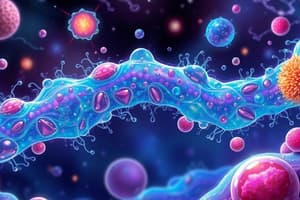Podcast
Questions and Answers
Which of the following factors can significantly influence a person's nutrition?
Which of the following factors can significantly influence a person's nutrition?
- Color of food consumed
- Age and gender (correct)
- Brand of food products
- Number of meals per day
Which of the following patients are most likely to require a modified diet?
Which of the following patients are most likely to require a modified diet?
- Athletes during training
- Healthy individuals with balanced diets
- Patients with chronic diseases (correct)
- Patients with no dietary restrictions
What is a common psychosocial factor that can impact a person's food choices?
What is a common psychosocial factor that can impact a person's food choices?
- Nutritional value analysis
- Taste preferences
- Availability of cooking facilities
- Education level (correct)
Which food source is rich in carbohydrates?
Which food source is rich in carbohydrates?
Which dietary component serves as a primary energy source for the body?
Which dietary component serves as a primary energy source for the body?
What type of modified diet may be necessary for patients on certain medications?
What type of modified diet may be necessary for patients on certain medications?
How can socioeconomic factors influence nutrition?
How can socioeconomic factors influence nutrition?
Which nutrient is primarily responsible for building new tissues in the body?
Which nutrient is primarily responsible for building new tissues in the body?
What is an essential component to improve a patient's appetite?
What is an essential component to improve a patient's appetite?
Which dietary approach is specifically designed to manage diabetes effectively?
Which dietary approach is specifically designed to manage diabetes effectively?
Which factor contributes to increased nutrient needs during adolescence?
Which factor contributes to increased nutrient needs during adolescence?
Which type of diet would be appropriate for a patient experiencing constipation?
Which type of diet would be appropriate for a patient experiencing constipation?
What should be checked before serving a food tray to a patient?
What should be checked before serving a food tray to a patient?
What nutrient requirement is higher for females compared to males before menopause?
What nutrient requirement is higher for females compared to males before menopause?
Which action is NOT recommended when serving food to a patient?
Which action is NOT recommended when serving food to a patient?
What psychological factor can influence food choices?
What psychological factor can influence food choices?
Which vitamin is not classified as water-soluble?
Which vitamin is not classified as water-soluble?
Which nutrient-enhanced diet focuses on increasing potassium intake?
Which nutrient-enhanced diet focuses on increasing potassium intake?
What should be done post-meal to assess a patient's dietary intake?
What should be done post-meal to assess a patient's dietary intake?
What is an important mineral for bone health?
What is an important mineral for bone health?
Which dietary intervention is important for patients on enteral nutrition?
Which dietary intervention is important for patients on enteral nutrition?
Which micronutrient's requirement may increase during pregnancy?
Which micronutrient's requirement may increase during pregnancy?
Which of the following is a true factor that affects nutritional habits?
Which of the following is a true factor that affects nutritional habits?
What is the primary function of water in nutrition?
What is the primary function of water in nutrition?
Flashcards are hidden until you start studying
Study Notes
Nutrition Overview
- Nutrition involves the relationship between organism and food intake, impacting body functioning.
- Essential nutrients are classified as organic and inorganic substances crucial for maintaining health.
- Adequate nutrition consists of a balance of macronutrients (water, carbohydrates, proteins, fats, vitamins, and minerals) and micronutrients.
Types of Nutrients
-
Carbohydrates: Provide energy; found in potatoes, bread, rice.
- Monosaccharides: Glucose, fructose, galactose.
- Disaccharides: Sucrose, lactose, maltose.
- Polysaccharides: Starch, glycogen, cellulose.
-
Fats: Source of long-term energy and insulation; include foods like cheese and avocado.
- Essential fatty acids include linoleic acid, linolenic acid.
-
Proteins: Vital for tissue building, found in egg, fish, and meat; composed of amino acids.
-
Vitamins: Facilitate nutrient use and hormone production; divided into fat-soluble (A, D, E, K) and water-soluble (B, C).
-
Minerals: Essential for bone and teeth health; include calcium, iron, magnesium, sodium.
-
Water: Facilitates nutrient transport, waste removal, and body temperature regulation.
Dietary Modifications
- Modified Diets: Necessary for patients with specific health conditions.
- Consistent Carbohydrate Diets: Aimed at diabetes management.
- Nutrient-Enhanced Diets: Higher potassium, iron, or calcium for specific deficiencies.
- Progressive Diets: Adapted based on intestinal health issues, incorporating low or high fiber options.
- Postoperative Diet Progression: Starting with NBM, then clear liquids, advancing to full liquids.
Factors Influencing Nutrition
-
Development:
- Adolescents have higher nutrient needs due to growth spurts.
- Older adults may require dietary modifications for chronic health risks (e.g., CHD, osteoporosis).
-
Sex:
- Distinct nutritional requirements based on body composition and reproductive functions.
- Pregnant women and lactating individuals have increased caloric and fluid needs.
-
Ethnicity and Culture: Food choices are influenced by cultural practices and beliefs, promoting variety and moderation.
-
Food Beliefs: Personal beliefs regarding health impact food choices, often shaped by media consumption.
Nursing Interventions for Nutrition
- Assess medical history and nutritional status to identify needs.
- Educate and assist patients/families on healthy eating habits.
- Reduce psychological barriers to eating, enhancing mood through social interaction.
- Ensure proper hygiene practices to improve appetite.
- Create a comfortable eating environment free from distractions.
- Serve appealing, well-prepared meals to stimulate interest in food.
Serving Food to Patients
- Verify dietary orders against patient records before serving.
- Ensure food preferences are acknowledged; check food temperature.
- Maintain attractiveness of food trays.
- Provide assistance for physical comfort and hygiene before meals.
- Document intake to monitor nutritional adequacy and needs.
Studying That Suits You
Use AI to generate personalized quizzes and flashcards to suit your learning preferences.




